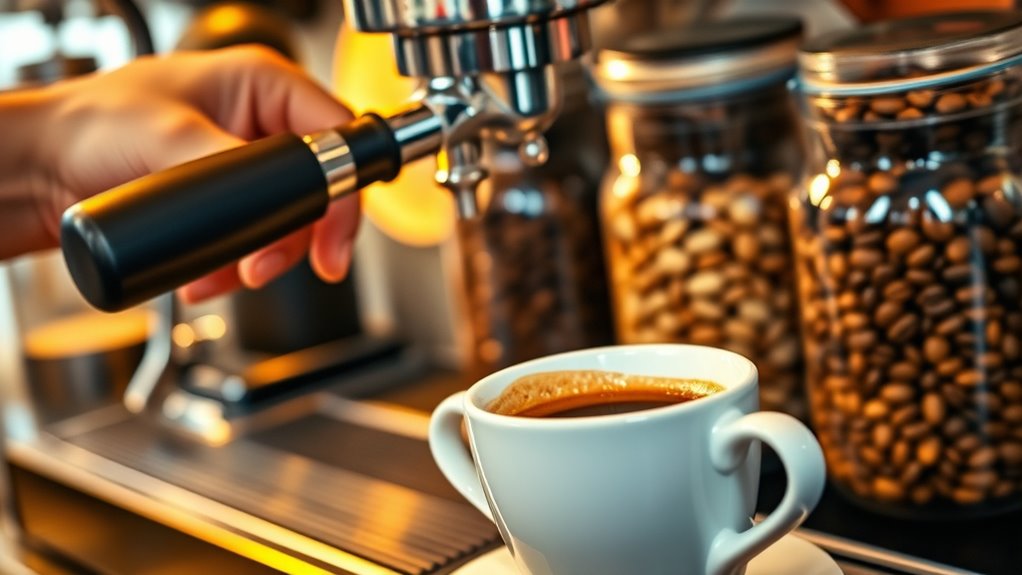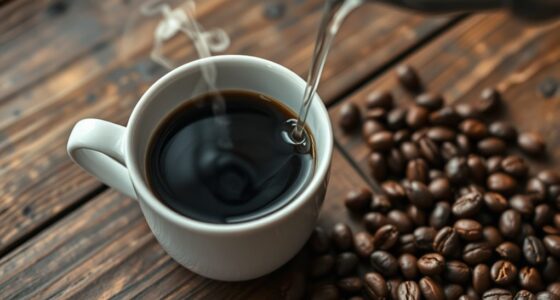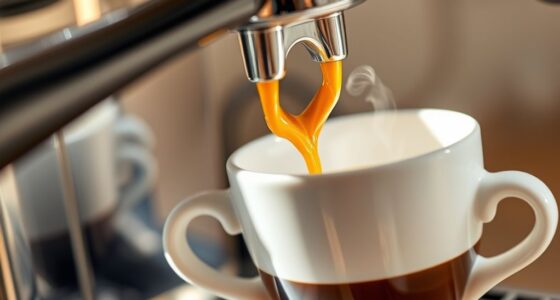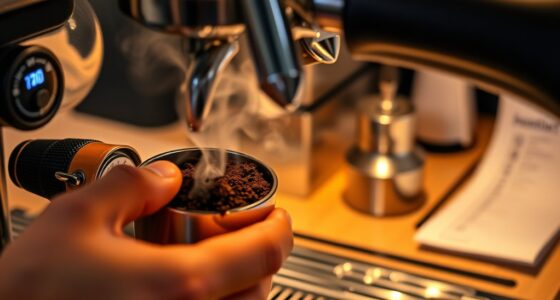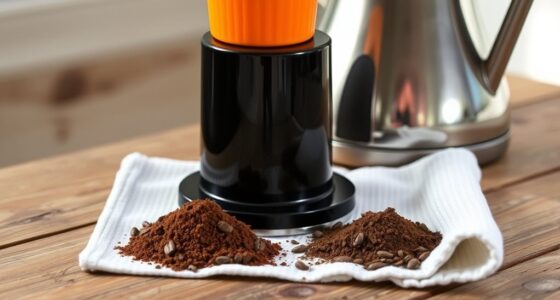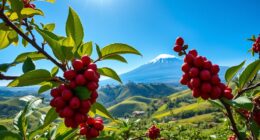To improve your coffee, start by checking your beans’ freshness and grinding just before brewing, matching grind size to your method. Measure carefully with a scale, control water temperature around 195-205°F, and tweak brew times to enhance flavor. Use a consistent pouring technique, optimize your equipment, and record your results. Making small adjustments helps highlight distinguishing notes of single origin or blends. Keep experimenting—there’s more to uncover for a perfect cup.
Key Takeaways
- Assess bean freshness, storage, and grind size to optimize flavor extraction for both single origin and blends.
- Control water temperature and brew time precisely to highlight unique notes or balance flavors.
- Use consistent pouring technique and equipment setup to ensure even extraction and clarity.
- Taste, record, and organize flavor impressions to identify subtle differences and refine your brewing process.
- Make incremental adjustments based on feedback and utilize resources for systematic improvement in your brew.
Assess Your Coffee Beans and Grind Size
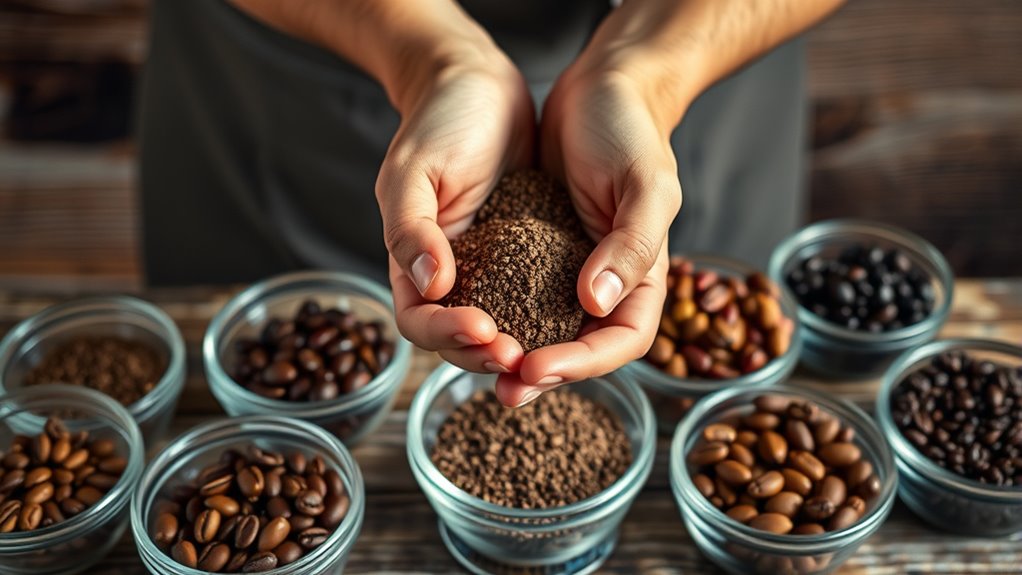
To guarantee your coffee tastes its best, start by examining your beans and grind size carefully. Freshness plays a vital role, so ensure your beans are recent; stale beans will dull flavors. Check the packaging for roast date and avoid beans that sit too long in storage. Proper storage methods, like airtight containers in a cool, dark place, help maintain bean freshness. When grinding, match the grind size to your brewing method—coarse for French press, medium for drip, fine for espresso. Using inconsistent grind sizes can lead to uneven extraction, ruining the flavor. Always grind just before brewing if possible, to preserve aromatic oils. Paying attention to bean freshness, storage, and grind size sets a strong foundation for a better cup. Additionally, being aware of relationships dynamics can help you better understand your own preferences and habits, leading to more mindful coffee choices.
Measure Your Coffee With Precision
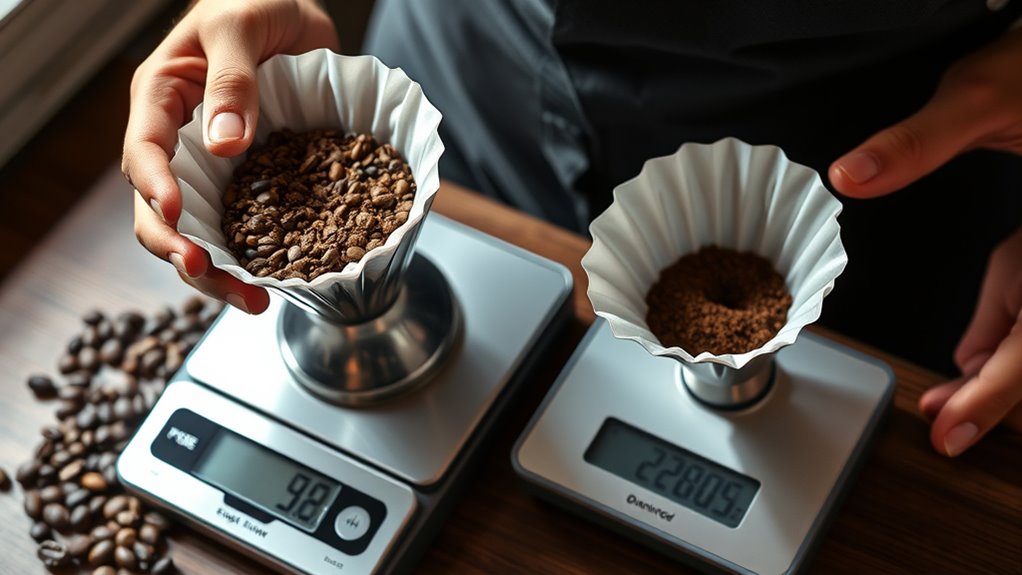
Accurately measuring your coffee guarantees consistent flavor and ideal extraction. Use precision tools like a digital scale to make certain each brew starts with the right amount. Standard measurement methods recommend about 18-20 grams of coffee per shot for espresso or 1 to 2 tablespoons for drip brewing. Consistency is key, so weigh your beans instead of relying on volume estimates. Keep your scale on a level surface and tare it before adding coffee. By mastering measurement methods, you eliminate guesswork and achieve uniform results each time. This precision allows you to better compare single origin beans to blends, understanding how specific quantities influence flavor. A small investment in quality measurement tools considerably improves your coffee craft and overall tasting experience. Incorporating sound therapy techniques into your routine can also help enhance your focus and mindfulness during brewing sessions.
Adjust Your Water Temperature
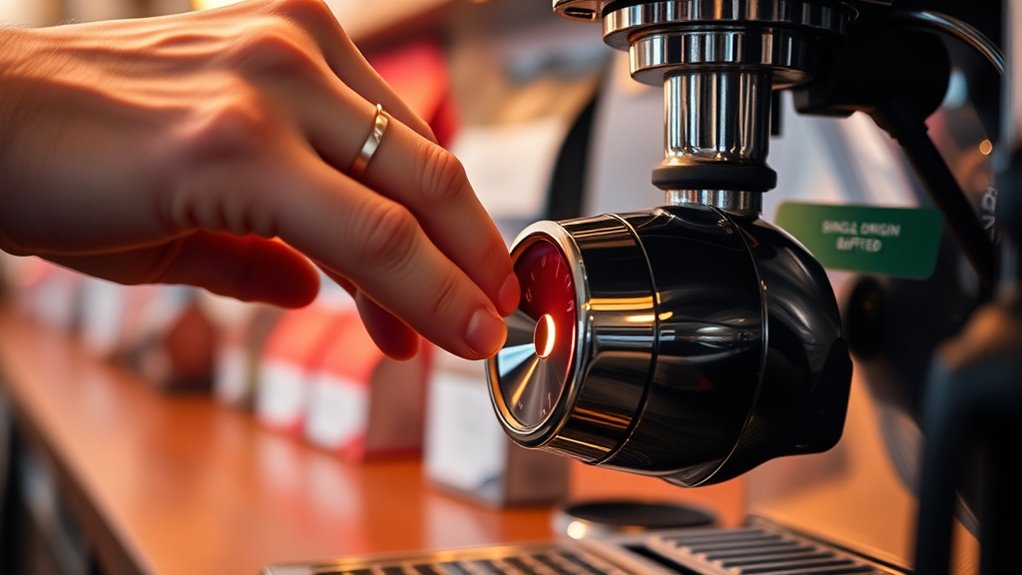
Have you ever noticed how a slight change in water temperature can dramatically alter the flavor of your coffee? Adjusting the water temperature helps you fine-tune the extraction balance, ensuring your coffee isn’t under- or over-extracted. For single origin beans, a slightly lower temperature (around 195°F) can highlight delicate floral and fruity notes. Conversely, a higher temperature (around 205°F) can bring out bolder, deeper flavors, ideal for blends with roasted profiles. Experimenting with water temperature allows you to control how quickly compounds are extracted from your coffee grounds. Remember, too hot can cause bitterness, while too cool can result in sourness and weak flavors. Using the proper brewing techniques can also enhance your results. Find the right water temperature to optimize flavor, aroma, and overall balance in every cup.
Experiment With Brew Time
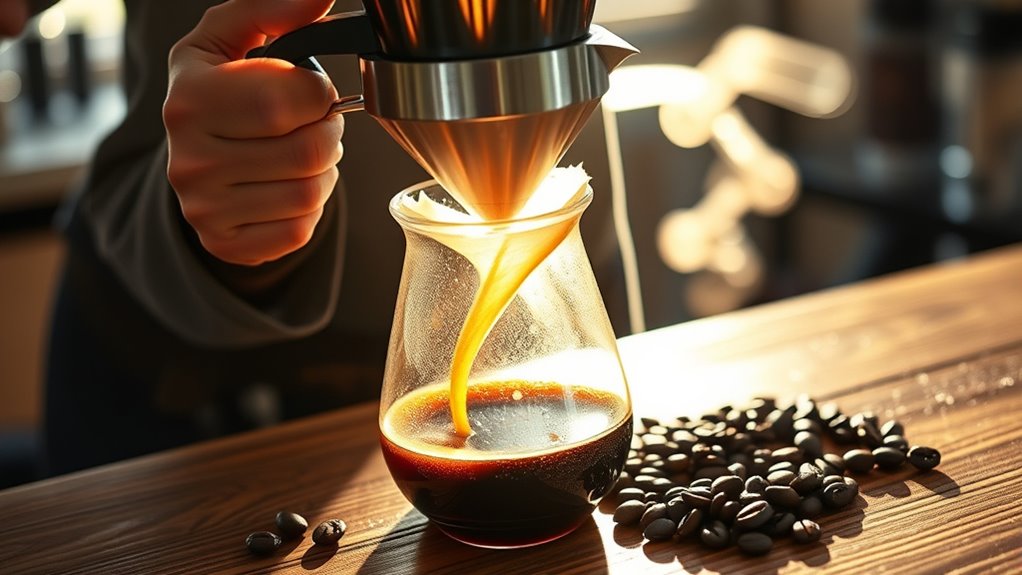
Adjusting your water temperature sets the stage for flavor, but how long you brew also plays a vital role in shaping your coffee’s profile. Your brew time determines the extraction length, affecting strength and complexity. If you’re brewing a single origin, a shorter brew time might highlight its delicate nuances, while a longer extraction enhances body and depth. With blends, experiment by adjusting the brew time to balance the combined flavors—sometimes a slightly longer extraction reveals richer notes. Keep track of your brew time carefully, as even small changes can considerably impact taste. The key is to find the sweet spot where your desired flavors are maximized without over-extracting bitter compounds. Play with different durations until you discover what best complements your specific beans. Experimenting with timing helps you refine your brewing process and achieve optimal flavor profiles.
Optimize Your Pouring Technique
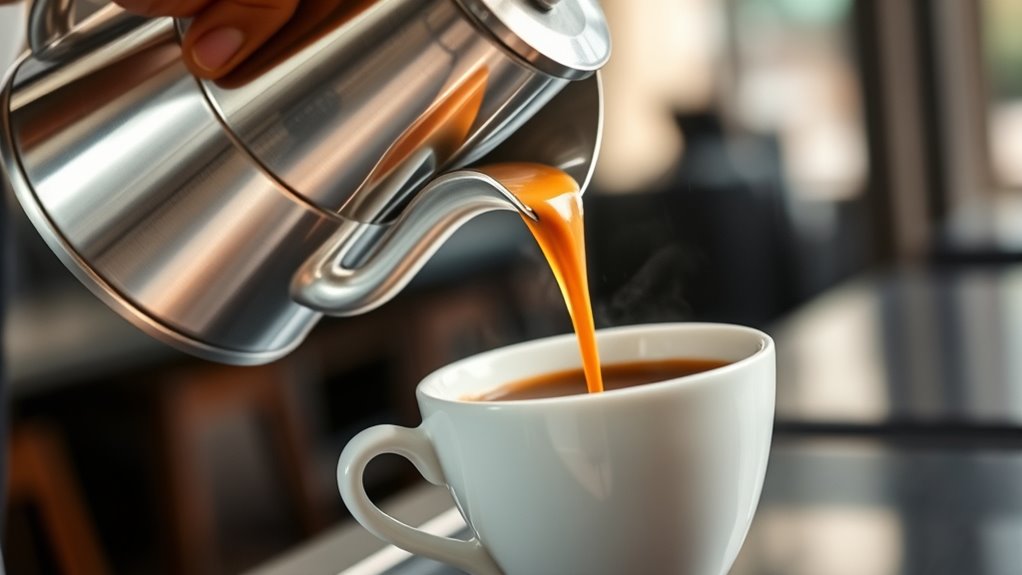
To improve your pour, focus on maintaining a consistent flow and angle. Keep your pour steady to make certain of even extraction and better flavor. Small adjustments can make a big difference in your overall coffee experience. Additionally, paying attention to pouring technique can help optimize your brewing process for better results.
Perfect Your Pouring Angle
Mastering your pouring angle can considerably enhance the extraction and flavor of your coffee. A proper pouring angle influences flow control, ensuring an even and steady pour. To perfect your technique:
- Keep the pitcher at a consistent angle—about 45 degrees—to control the flow and prevent splashing.
- Aim for a smooth, circular motion, maintaining the same angle throughout to ensure even extraction.
- Adjust your wrist movement subtly to regulate the flow rate, avoiding sudden changes that can disrupt brewing.
Maintain Steady Flow Rate
Maintaining a steady flow rate is essential for consistent extraction and balanced flavor. At your brew station, controlling your pour ensures each cup highlights the coffee’s true character. Water quality plays a role too—use clean, fresh water to prevent uneven extraction. To help you stay consistent, consider this flow rate guide:
| Pour Speed | Effect on Extraction | Tips |
|---|---|---|
| Slow | More control, richer flavors | Use a steady, gentle pour |
| Moderate | Even extraction, balanced taste | Practice consistent speed |
| Fast | Risk of under-extraction | Pour smoothly without rushing |
| Varies | Inconsistent flavor | Maintain a stable flow |
Consistent pouring technique echoes the Victorian-inspired emphasis on craftsmanship and precision. Keep your pour steady and water quality high for the best possible brew.
Tweak Your Filter and Equipment Setup
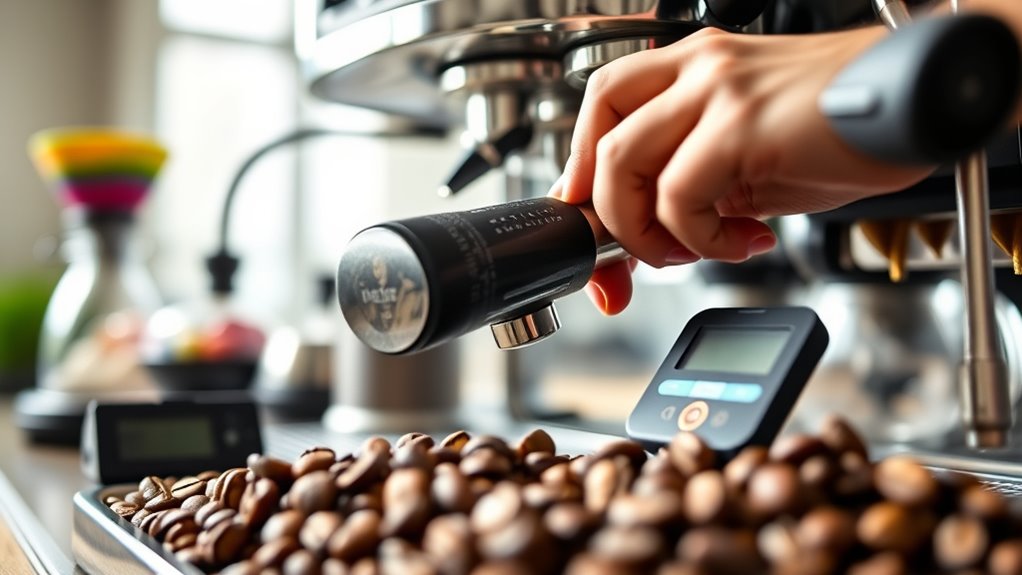
Start by adjusting your grind size to match your brew method, ensuring water flows through evenly. Next, check your equipment setup to prevent leaks or blockages that could affect flavor. Small tweaks here can make a big difference in highlighting the unique qualities of your coffee.
Adjust Grind Size
Adjusting your grind size is a crucial step in fine-tuning your brew, especially when switching between single origin beans and blends. The grind size affects extraction, flavor, and overall balance. To optimize your coffee, consider these steps:
- Adjust grind size: Use a finer grind for more delicate, nuanced single origin beans, and a coarser grind for bold blends.
- Monitor water temperature: Higher temperatures extract more flavors; match your grind size accordingly.
- Taste and tweak: Brew a shot or pour-over, then adjust the grind size until you achieve the desired clarity and body.
- Ensure consistent grind size with your equipment setup for reliable results.
Optimize Brew Equipment
Tweaking your filter and equipment setup can markedly improve your brew’s clarity and flavor. Start by ensuring your equipment is clean—residue can dull coffee flavor and obscure brewing clarity. Adjust your filter choice; a finer filter enhances clarity but may slow extraction, while a coarser filter boosts body. Check your brewing parameters:
| Equipment Adjustment | Effect on Coffee Flavor & Clarity |
|---|---|
| Filter Material (paper, metal) | Improves clarity or adds body |
| Grind Size Compatibility | Ensures ideal extraction |
| Water Temperature | Balances flavor extraction and clarity |
Fine-tuning these elements helps you get a more defined, flavorful cup, whether highlighting the unique notes of single origin or blending for complexity. Small adjustments can make a big difference in achieving your ideal coffee experience. Additionally, understanding how proper extraction works can help you dial in your brew for maximum flavor clarity.
Taste and Record Your Results
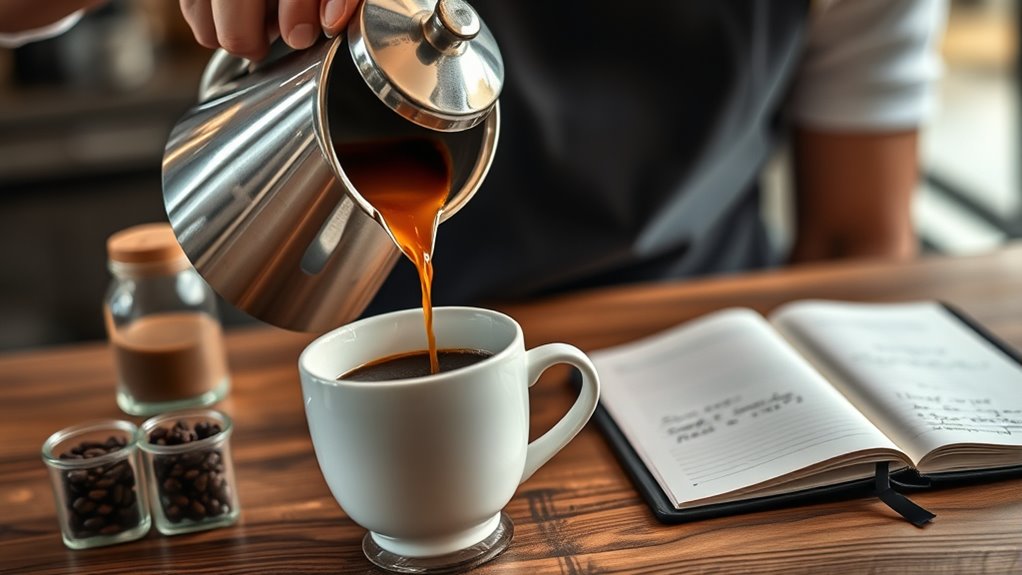
As you taste each coffee, pay close attention to its flavor profile, aroma, and overall balance. This will help you identify subtle differences and similarities. To get the most out of your tasting, consider these steps:
- Note the flavor profile—identify dominant tastes like fruity, nutty, or earthy notes.
- Observe the aroma enhancement—how the smell complements or elevates the flavor.
- Record your impressions concisely, focusing on clarity and consistency.
- Remember that taste perception can vary based on individual palate sensitivity, so trust your own experiences as you compare.
Keep your notes organized to track how each brew’s taste evolves. This process not only clarifies which coffee suits your preferences but also refines your ability to distinguish nuanced aroma enhancements. Accurate documentation makes your comparisons more meaningful and guides future adjustments.
Make Incremental Adjustments for Consistency
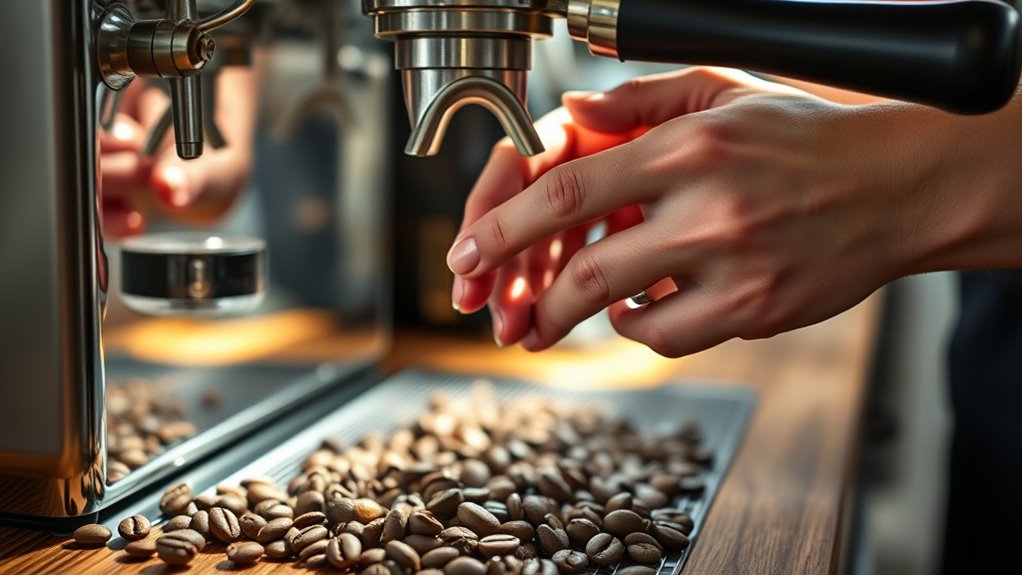
To achieve consistent results, you should make small, incremental adjustments to your brewing variables rather than large changes at once. Changing one factor at a time helps you understand how each affects the bean origin’s flavor profile. For example, slightly tweaking the grind size or brewing time can highlight subtle nuances from different origins or blends. Keep detailed records of each adjustment and the resulting flavor profile, so you can identify patterns and refine your process. This method ensures you don’t overshoot desired results and helps maintain a predictable, balanced cup. Over time, these slight tweaks help you better appreciate the unique characteristics of single origin coffees versus blends, ultimately guiding you toward your perfect brew with consistency. Utilizing app support features can also assist in tracking your adjustments and progress more efficiently.
Frequently Asked Questions
How Do Different Origin Beans Affect Flavor Profiles?
Different origin beans markedly impact flavor profiles because each region’s climate, soil, and altitude create unique taste characteristics. With single origin beans, you’ll notice distinct flavors like fruity, floral, or earthy notes that reflect their specific location. You can better appreciate the nuances by tasting different origins side by side. This variety helps you identify your preferences and enjoy a broader range of rich, authentic flavor profiles.
Can Blend Ratios Be Adjusted for Specific Taste Outcomes?
Yes, you can adjust blend ratios for specific taste outcomes. By tweaking brew ratio adjustments, you control the balance of flavors in your coffee. Experiment with different proportions to enhance sweetness, acidity, or body, tailoring each cup to your preferences. This flavor customization process allows you to fine-tune blends, ensuring every brew delivers the exact flavor profile you desire, making your coffee experience uniquely yours.
What Impact Does Water Mineral Content Have on Extraction?
Water mineral content, especially water hardness and mineral balance, profoundly impacts extraction. Hard water with high mineral content can cause over-extraction, making your coffee taste bitter or overly robust. Conversely, water with balanced minerals ensures ideal extraction, highlighting coffee’s nuanced flavors. When you adjust your water’s mineral profile, you control extraction quality, resulting in a more balanced, flavorful cup. Proper mineral balance enhances clarity and aroma, improving your overall brewing experience.
How Does Ambient Temperature Influence Brewing Consistency?
Did you know that even a 2°C fluctuation in ambient temperature can impact your brewing consistency? Ambient temperature influences temperature stability, which is vital for brewing accuracy. When your environment stays steady, your coffee extraction becomes more predictable, ensuring a consistent flavor profile. By controlling ambient temperature, you help maintain ideal brewing conditions, making your coffee taste reliably great every time without guessing or adjusting too much.
Are There Ideal Storage Methods to Preserve Bean Freshness?
To preserve bean freshness, you should use airtight packaging techniques, like vacuum-sealed bags or opaque containers with tight seals, to limit exposure to air, light, and moisture. Store your beans in a cool, dark place away from heat sources. Keep in mind that storage duration matters; try to use your beans within a month for maximum freshness, as longer storage can degrade flavor and aroma.
Conclusion
Now that you’ve got these quick tips, you’re ready to elevate your coffee game. With just ten minutes of adjustments, you can access richer flavors and better distinguish your single origin or blend. Are you ready to turn your routine into a true tasting experience? Remember, small tweaks can lead to big improvements. Keep experimenting, stay curious, and enjoy every perfect cup that comes from your newfound skill. Cheers to better coffee!
